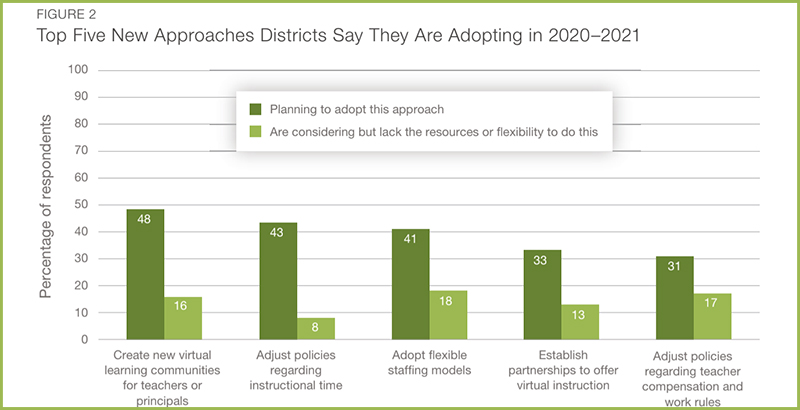Analysis: Survey of District Leaders Shows Online Learning Is Here to Stay. Some Ways of Making It Work for Students Beyond the Pandemic

Many teachers and students are struggling with online learning during the COVID-19 pandemic. And with a new, nationally representative survey of school district leaders confirming that remote coursework is likely here to stay, school systems are going to need to apply the lessons from their forced experiments with remote learning during the COVID-19 pandemic to better adapt.
The first survey conducted through the new American School District Panel shows 1 in 5 districts are considering, planning to adopt or have already adopted a fully online school in future years. One in 10 has adopted blended or hybrid instruction, or plans to. Of all the pandemic-driven changes in public education, the creation of virtual schools was the change that the greatest number of district leaders anticipated would continue into the future.
The reasons for continuing online instruction after COVID-19 are accommodating parent and student demand, meeting the diversity of students’ needs and maintaining student enrollment — all at a time when many parents and teachers are afraid for a return to in-person schooling.
Still, while online learning is likely to remain a bigger part of public education than before the pandemic, it poses major challenges.
In October, teachers in RAND’s nationally representative American Teacher Panel gave very poor ratings for online learning: Teachers worked more hours during COVID-19 than during regular school, yet their students were less prepared for grade-level work, as well as less accountable for completing it.
These findings should not be surprising. Research even before the pandemic raised a number of red flags about online learning. For example, students enrolled in online schools had poorer outcomes in math, reading and other subjects when compared with students in traditional schools. Much instructional content was not aligned to standards or adapted to the needs of students with disabilities or English learners.
As school systems across the country learned when they were forced to suddenly close in spring 2020, remote instruction is a fundamentally different task than what school districts are designed for. A deeper dive into six school systems’ efforts to navigate the spring school closures and shift to remote learning by the Center on Reinventing Public Education reveals how sweeping the challenges of remote and online learning can be.
In the six case studies, district leaders reported that in the immediate aftermath of school shutdowns in March, they had to scramble to provide food, social services and internet connectivity, among other basic necessities, for hundreds or even thousands of children. The best they could do for remote learning at the time was to provide paper worksheets.
Remote offerings have improved, yet none of the six districts believe they have cracked the code on how to provide a consistently high-quality, online instructional experience. They acknowledged big differences between teachers and schools in content covered and student engagement, and want to increase the numbers of students with access to the best materials. Some also anticipate needing to look outside their districts for online programs.
There is hope, however. Together, the survey and examinations of the six districts’ experiences suggest how different stakeholders can use pandemic-related momentum to make online learning a common staple of public schooling:
Addressing the digital divide. There are sizable gaps between who has and does not have access to information technology in rural and urban communities alike.
Updating policies like seat time requirements and attendance policies. These will need to reflect flexible online learning models where schooling does not necessarily occur on the same standard schedule for each student.
Allocating federal funding to support states’ development of free online curriculum materials and platforms. This would allow states to work with publishers that already have high-quality curricula (such as ones the independent organization EdReports has identified) adaptable for online learning. Materials should also support special education students, as well as English learners. Teacher certification and professional learning programs could focus on how to choose and use the best online tools.
Continuing district partnerships with local social service agencies built during the pandemic. These partnerships could support families as co-educators and promote home environments conducive to learning.
Remote K-12 learning at scale is an unprecedented challenge for everyone involved. It can and would improve dramatically if educators, government and philanthropy treated it as a work in progress, featuring evidence-based development of quality online curricula, continuous improvement and engagement of teachers.
Heather Schwartz is director of the pre-K-to-12 educational systems program and a senior policy researcher at the nonprofit, nonpartisan RAND Corporation. Paul Hill, a political scientist, is founder of the Center on Reinventing Public Education and a former RAND senior social scientist.
Get stories like these delivered straight to your inbox. Sign up for The 74 Newsletter

;)
